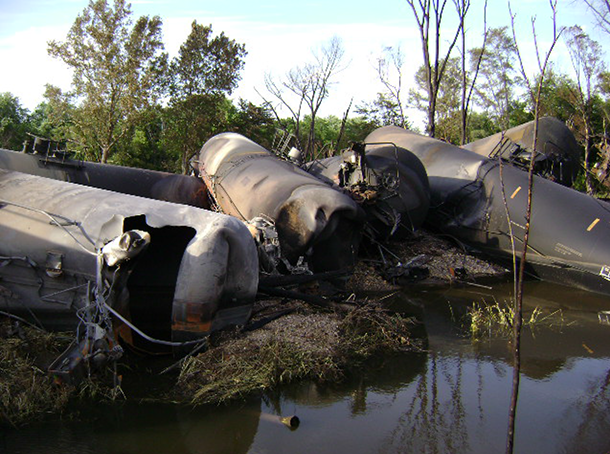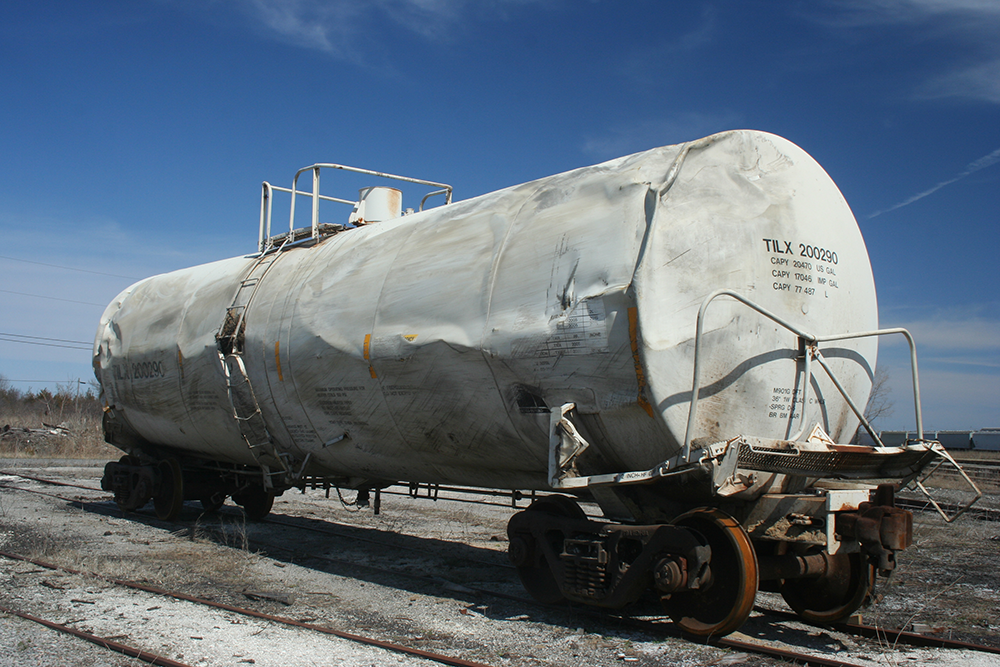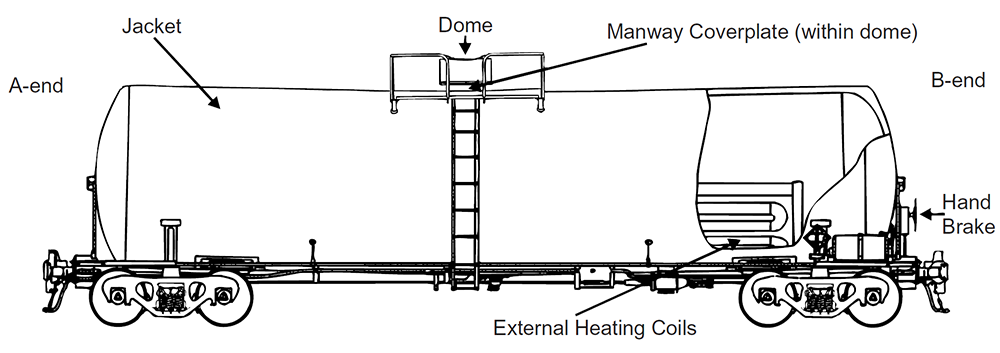Oil Train Safety Off Track
Air Date: Week of March 20, 2015

Five oil train derailments in five weeks--some with dangerous fiery consequences. (Photo: Wikimedia Commons)
In the past five weeks, there have been 5 oil train derailments resulting in large fireballs, and more oil was spilled in 2014 than in the last 38 years combined. Steve Kretzmann, Director and Founder of Oil Change International, and Sarah Feinberg, Acting Administrator of the Federal Railroad Administration, discuss rail safety with host Steve Curwood and offer different solutions to this multifaceted problem.
Transcript
CURWOOD: From the Jennifer and Ted Stanley Studios in Boston and PRI, this is Living on Earth. I’m Steve Curwood. At 12 million barrels a day, the US is the world’s leading oil producer, with much of the boost due to fracking technology. With pipelines at capacity the boom has led a 4,000 percent increase in the volume of crude oil that travels by rail, and that brought more accidents and more oil spills in 2014 than over the previous 38 years. Just these past five weeks brought five more derailments, with huge fires and polluted waterways, and some critics say new rail safety rules on the drawing boards won’t go far enough to protect the public or the environment. Steve Kretzmann is Executive Director and Founder of Oil Change International. Welcome to Living on Earth, Steve.
KRETZMANN: Thanks so much for having me here, Steve. It's great to be back.
CURWOOD: Now, what we are seeing is a lot of crashes and explosions. What's happening?
KRETZMANN: So we're seeing, unfortunately, a very visible result of the ‘all of above’ energy policy, playing out with great risks to our communities around North America on a whole. The Bakken oil is very light oil, and it's very explosive, it turns out, and people have known this, but it hasn't really stopped them from shipping it via rail. And it's also worth noting that because that oil is light oil, that's mixed in with tar sands to form diluted bitumen, which is usually the way tar sands get to market, we're also seeing tar sands trains now explode, and so they're just trying to get as much out as fast as they can and maximize their profit. And as we know, the oil market is flooded with crude now and effectively we're subsidizing that with our safety in our communities and our lives.
CURWOOD: Now, in Texas where there's a fair amount of fracking for oil, there are machines that remove the most volatile portion, the most explosive part of fracked oil before it is shipped, but in North Dakota it is not. Why this discrepancy? Why don't they make this safety precaution in North Dakota?
KRETZMANN: Well, it's about profit, it's about investment and infrastructure by the industry, so the production in Texas is very close to markets and so when they invest in the infrastructure to remove the lighter petroleum product - natural gas among other things - they can then sell that oil because they can put in the pipelines. On the other hand, North Dakota does not have those gas pipelines and the infrastructure is not there to capture it and so their options are burn it or try to force it into the tank car, which is what they're doing. There are new regulations that are supposed to take effect from North Dakota that will reduce the amount that they can squeeze in there on a regular basis, but it's not clear that the regulation is in line with what will actually create a safe car. It's just slightly less than they've been able to get away with.

Older DOT 111 cars usually do not fair well in crashes, even at low speeds. (Photo: Robert Taylor; Flickr Wikimedia Commons CC BY 2.0)
CURWOOD: Talk to me about the new tanker safety rules and how effective they might be in preventing the kind of explosions we've seen on oil train derailments.
KRETZMANN: So it's not clear what the new rules are going to be. There are the North Dakota rules which are a slight reduction in vapor pressure, and then there are the federal rules, which are under consideration by the Obama administration, and we're going to see another draft of those supposedly within the next month. But there are very different options that they can take. They could build thicker-walled oiled trains, they could require that, but the oil industry doesn't like that because it costs them more money. They could install electronically controlled pneumatic brakes on the railcars, but the rail industry doesn't like that because it costs them too much money. One of the most effective things they could do is introduce a very serious speed limit. The DOT 111s, the old cars, still make up the majority of the crude by rail fleet; they've been shown to explode at seven miles an hour. The 1232s, which are the newer supposedly safer cars, but are the ones that have been involved in each one of these accidents recently, have been shown to explode at 15 miles an hour. So, we say you should put in serious restrictions here: all new cars, speed limits at 15 or below, particularly in populated areas. You know the industry gets very upset about that and says, “oh my God, that would mean we would have to stop production”. And you know, the point is “yes”, maybe actually reducing some production in the name of public safety is worth it here.

Steve Kretzmann is the Founder and Executive Director of Oil Change International. (Photo: courtesy of Mr. Kretzmann)
CURWOOD: So you mentioned that communities are at risk from these crude oil trains. What ones come to mind for you?
KRETZMANN: So when you look at the map of where crude oil trains are going around the United States, it's very clear you start looking at the routes: Minneapolis, Chicago, St. Louis, New York, Philadelphia, Cleveland, Detroit. All these cities have crude by rail trains, these bomb trains running right through them. 25 million Americans live within the blast zone here and it's sadly not a question of if but when one of these explosions is going to result in a tremendous tragedy. We have the opportunity to slow this down and put a moratorium in place before this happens and we should take it.
CURWOOD: That was Steve Kretzmann of Oil Change International. Well, a moratorium on oil transport by rail is unlikely, and the Obama Administration has yet to issue new rules, even after two years of work. So in the face of the recent accidents it’s issued some emergency rules and here to explain is Sarah Feinberg the Acting Administrator for the Federal Railroad Administration. Welcome to the program.
FEINBERG: Thank you for having me.
CURWOOD: So what do you have in place now in terms of emergency regulations then, emergency rules?
FEINBERG: Well, we have a lot. We have a requirement of railroads to share information about the product that's being transported with emergency responders in each state. We have an emergency order that's in place regarding testing and making sure that the right tank car and right packaging is being used for each product. Over the course of a year and a half that I've worked on this issue, we were enforcing against violations for not testing the product properly, not packing it in the right container, not handling it the right way, not sharing information about it. I'm not saying things are in a good place now, they certainly aren't. We've got a long way to go, but when I think back to where we were a year and a half ago, it's amazing to me we're actually having a conversation about testing then.

A DOT-111 tank car with an insulating jacket and external heating coils can hold 20,000 gallons of crude. (Photo: National Transportation Safety Board; Wikimedia Commons)
CURWOOD: Now, not long ago there was a dramatic explosive derailment in West Virginia that involved the new kinds of cars, the supposedly safer cars, and some folks are saying that apparently having those cars aren't safe enough. What you say?
FEINBERG: Well, it's really important to understand the different kinds of cars that are out there. The one we hear about a lot is the DOT 111. That is the older tank car; I think everyone agrees across the board that tank car is certainly outdated. It's not safe enough to hold this product or others. Industry on its own a few years ago came up with their own version of a tank car that's called the 1232. While it is a better tank car, and it's a newer version of a tank car, one person on my team once referred to the 1232 as the .111 with a five-mile per hour bumper on it. So it's a Pinto with a better bumper instead of just a Pinto. The other most important thing to think about is that all 1232s are not the same. They didn't have all the safety components that they could have had. They didn't have a jacket; they didn't have a thermal shield. These are important components to keep a tank car from basically experiencing the thermal events that create fireballs.
CURWOOD: No matter what kind of car it is, they're going off the rails. Some folks say that the trains are just simply traveling too fast.
FEINBERG: Look, I mean speed should be a factor, but the reality of is that in all of these derailments, they've been very low speed. In fact, the agreements that we have in place with the railroads limit speed at 40 miles an hour. We're now in a position where we've got railroads functioning below the maximum speed and we are still running into problems. There is not a tank car at this moment or even the new version of the tank car we've proposed that will survive a derailment above, say, 16 or 18 miles an hour. So that's one of the reasons why this issue is so complicated. There is literally not a silver bullet. It's not speed, it's not a particular tank car, its not the way the train is operated. It's all of the above and it needs to include, frankly, the product itself that's being placed in the transport, the product that's leaving the Bakken and heading to the refinery.
CURWOOD: How safe is it to allow such volatile fuel to be transported on rails?

Sarah Feinberg is the Acting Administrator of the Federal Railroad Administration. (Photo: FRA)
FEINBERG: I mean, if I have to be honest, I would prefer that none of this stuff be traveling by rail. I worry a lot about not just the folks who are working on the train and the passengers on the Amtrak that the train is going by, but I worry a lot about the people living in the towns and working in the towns that these trains are going through. Now, we have some routing protocols in place. There is a whole software system that the railroads use when they are trying to determine the right route for a substance like this, so it looks at things like city size, it looks at possible defects on rail, it looks at weather, it looks at speed, it looks at traffic, it looks at all of those factors and it basically spits out the best route for you to take.
CURWOOD: Industry a few days ago went over to the Office of Management and Budget, the folks who review the rule-making there inside of the OMB, and made a lot of complaints about the proposal to have this updated form of braking, they say it won't have more significant safety benefits, it won't have much in the way of business benefits and be extremely costly. Sounds like industry is pushing back against getting this stuff under control. Your take?
FEINBERG: Yeah, sure. And I expect that. Look, OMB meets with industry, yet the FRA is required to meet with all interested parties as well. So, as many meetings as I did with industry, I think we all did with the environmental community, small-town mayors, governors and interested members of Congress. So there are a whole lot of folks with a dog in this fight and they all want to talk to the regulator and they all want to talk to the Office of Management and Budget to affect the outcome of the rule. I think at the end of the day it's OMB's job and it's FRA's job to come up with the best possible rule that we can that will actually address the challenge. To be clear, that's not an easy thing to do right now. It's a bit amazing at this point you can take a common sense safety measure and watch the amount of time that it can actually take to turn into a regulation, but you know that's my frustration, that's our problem and our issue to deal with, and the main thing is we should just be keeping people safe.
CURWOOD: Sarah Feinberg is the Acting Administrator for the Federal Railroad Administration. Thanks so much for taking the time today.
FEINBERG: Thanks for having me.
CURWOOD: We asked the Association of American Railroads for comment on the proposed new regulations.
Spokesman Ed Greenberg’s reply is posted in full at our website, LOE.org.
It reads, in part: “America’s rail industry believes final regulations on new tank car standards by the federal government would provide certainty for the freight rail industry and shippers and chart a new course in the safe movement of crude oil by rail.”
Coming up...the power of labor allied with environmental activists. Stay tuned to Living on Earth.
The Association of American Railroads comment:
“The safety of the nation’s 140,000-mile system is a priority of every railroad that moves the country's economy and the freight rail industry shares the public's concern over recent high-profile incidents involving crude oil. This is a complex issue and a shared responsibility with freight railroads and oil shippers, which are responsible for properly classifying tank car contents, working together at further advancing the safe movement of this product.
The fact is, safety is built into every aspect of the freight rail industry, it is embedded through-out train operations and a 24/7 focus for thousands of men & women railroaders. Billions of private dollars are spent on maintaining and modernizing the freight rail system in this country. Since 1980, $575 billion has been spent on safety enhancing rail infrastructure and equipment with another $29 billion, or $80 million a day, planned for 2015.
Railroads have done top-to-bottom operational reviews and voluntarily took a number of steps to further improve the safety of moving crude oil by rail. Actions have included implementing lower speeds, increasing track inspections and track-side safety technology, as well as stepping up outreach and training for first responders in communities along America's rail network.
Federal statistics show rail safety has dramatically improved over the last several decades with 2014 being the safest year in the history of the rail industry. More than 2 million trains move across our country every year hauling everything Americans want in their personal and business lives with 99.995 percent of cars containing crude oil arriving safely. That said, the freight rail industry recognizes more has to be done to make rail transportation even safer.
Freight railroads do not own or manufacture the tank cars carrying crude oil. Still, the freight rail system has long advocated for tougher federal tank car rules and believe that every tank car moving crude oil today should be phased out or built to a higher standard. We support an aggressive tank car retrofit or replacement program.
America’s rail industry believes final regulations on new tank car standards by the federal government would provide certainty for the freight rail industry and shippers and chart a new course in the safe movement of crude oil by rail.”
Links
Interactive Map: North American Crude by Rail
“Yet Another Oil Train Disaster”
PHMSA helped FRA prepare the railroad safety proposal to the White House
“U.S. rail industry pushes White House to ease oil train safety rules”
The newer oil tank cars, CPC-1232s, were involved in each of the recent derailments
Living on Earth wants to hear from you!
Living on Earth
62 Calef Highway, Suite 212
Lee, NH 03861
Telephone: 617-287-4121
E-mail: comments@loe.org
Newsletter [Click here]
Donate to Living on Earth!
Living on Earth is an independent media program and relies entirely on contributions from listeners and institutions supporting public service. Please donate now to preserve an independent environmental voice.
NewsletterLiving on Earth offers a weekly delivery of the show's rundown to your mailbox. Sign up for our newsletter today!
 Sailors For The Sea: Be the change you want to sea.
Sailors For The Sea: Be the change you want to sea.
 The Grantham Foundation for the Protection of the Environment: Committed to protecting and improving the health of the global environment.
The Grantham Foundation for the Protection of the Environment: Committed to protecting and improving the health of the global environment.
 Contribute to Living on Earth and receive, as our gift to you, an archival print of one of Mark Seth Lender's extraordinary wildlife photographs. Follow the link to see Mark's current collection of photographs.
Contribute to Living on Earth and receive, as our gift to you, an archival print of one of Mark Seth Lender's extraordinary wildlife photographs. Follow the link to see Mark's current collection of photographs.
 Buy a signed copy of Mark Seth Lender's book Smeagull the Seagull & support Living on Earth
Buy a signed copy of Mark Seth Lender's book Smeagull the Seagull & support Living on Earth

